|
Hall-Scott Motor Car Company in
World War Two
Berkeley, CA
1910-1958
A Division of American Car and Foundry Motors Company during World War
Two.
This page updated 11-8-2020.
The Hall-Scott Motor Car Company was formed in
1910 by Elbert John Hall and Bert Scott. The new
company's location was at the corner of 5th Street and Snyder (Currently
Heinz Street) in Berkeley, CA. When the company ceased operations in Berkeley in
1958 it owned 13 acres, and the plant ran all the way down to 7th Street. E.J.
Hall was the technical genius of the company and had been designing
gasoline powered engines ever since 1901, when he was 19 years old. It was
his technical expertise that kept the small company in business with new
engine designs to meet the changing business conditions of the early
20th century.
The original products of the Hall-Scott Motor
Car Compay were
gasoline powered motor cars for railway use. The company built 23
of these motor cars for the local rail companies on the west coast.
The most interesting of these motor cars was a 62-foot long, 100-ton
armored fighting vehicle for the U.S. military during World War One.
The vehicle had 3/4-inch armored plates on the sides, and a roof
with 1/2-inch armored plate. E.J. Hall took two four-cylinder engines
and bolted them together to make straight eight engine of 7,736 cu. in. and 300
hp. The engine was connected to a three-speed transmission that
could run 60mph in either direction.
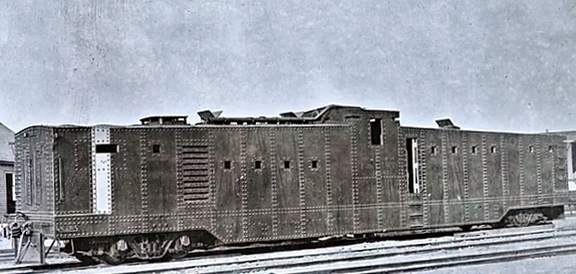
The company diversified in 1911 and started
building engines for the aviation industry. Before World War One,
Hall-Scott was well
respected in that industry. In 1917 E.J. Hall and Jesse Vincent, from
the Packard Motor Car Company, got together and designed the Liberty
Aviation Engine for the American military. While Packard would later
garner the credit for the design of this engine, Elbert Hall's input has
been overlooked by historians. While the small Hall-Scott Company
could not compete with Packard in the media for proper credit for the
development of the Liberty engine, it did publish a post-World War One
25 page pamphlet detailing its input into the engine.
After the war, Hall-Scott abandoned the aviation market and began to
focus on the automotive, truck and boating market. E.J. Hall
designed two engines for Ford Motor Company in 1919. He also
designed several truck engines for International Harvester, and this
series of engines had significant volume for the company over many
years.
In 1925 American Car and Foundry purchased the
Hall-Scott Motor Company to provide engines for the buses it was
building. Prior to the purchase by American Car and Foundry,
Hall-Scott had entered the marine market with several engines that were
adapted from its truck and automobile engines. These were used in
smaller boats, but the company needed an engine in the 250 hp range to
effectively compete in the market. With the financial backing
American Car and Foundry, E.J. Hall designed the 250 hp Invader
marine engine. This was the last engine E.J. Hall would design for
the company before he left it. This engine was the company's most
important contribution to helping win World War Two. The
Invader was a six-cylinder marine engine that was later modified by
company engineers at the start of World War Two. One modification became the 440
that was used in M26 and M26A1 Tank Retriever. The other was the V-12
Defender Marine engine that became the engine of choice for many
mid-size high-speed rescue boats.
E.J. Hall left the company in the late 1920s,
probably because American Car and Foundry was providing
leadership he did not agree with. Without his technical guidance
and genius, all the engineers in the company could do was re-design the
Invader engine for new applications long after engine technology had
moved forward. The Invader engine in some form would be produced
for another 31 years, with approximately 3,400 produced prior to the end of the Hall-Scott line of
engines. E.J. Hall would work for several other companies, but
never had the impact on cutting-edge engine technology that he had at the company with his name
on it.
Bert Scott left the company in 1938, ten years
after E.J. Hall. When Hall-Scott entered World War Two, neither
of its founders were still with the company. During the war,
Hall-Scott built 12,226 engines for various small boats and one tank retriever.
After World War Two, the company would struggle as diesel engines
started making deep cuts into the gasoline engine market for trucks and
busses. Without E.J. Hall, the company did not have the technical
depth to design a competitive diesel engine. After changes in
ownership and failed attempts at diversification, Hall-Scott Motor
Company was purchased in 1958 by Hercules Motors Corporation of Canton,
OH. All of the necessary tools and documentation to build the
engines were moved to Canton. Hercules would continue to build some
of the Hall-Scott designs, and itself would be purchased by Hupp.
Then White Motor Company would purchase Hercules
from Hupp. Nine
years later, the last Hall-Scott designed engine was produced in the
Canton, OH factory, sixty years after Mr. Hall and Mr. Scott formed a
company to make motorized rail cars.
World War Two: Hall-Scott engines
were always known for their power, precision, and endurance. While
the company did not make that many engines compared to other engine
companies during World War Two, they did find several important niches
during the war. The V-12 Defender engine powered over 600 63-foot
rescue boats used by both the U.S. Army and Navy.
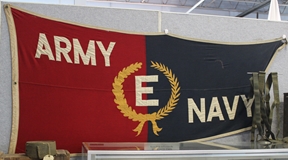
Hall-Scott Motor Company won the Army-Navy
"E" Award five times during World War Two.
The original award was won in 1942.
Hall-Scott Motor Company World War Two
Production Statistics: 12,226 total 440, 441, Invader and
Defender engines. This number is from the historical record of
total engines built by the company for the years 1941-1945.
However, the same historical record gives the individual production
numbers for the four types of engines Hall-Scott produced during the
same period when added up in Table 1 as 9,909. Some of what may be missing
are the production numbers of Invader engines built in 1941.
|
Hall-Scott Motor Company World War Two Engine Data - Table 1 |
|
Engine Type |
Engine Data |
Number
Built |
Applications |
Comments |
| 440
|
1091
cu. in. six-cylinder 240 hp @2100rpm |
1,701 |
M26
and M26A1 "Dragon Wagon" Tank U.S. Army Tank Retriever |
There
was a total of 1,372 M26 and M26A1s built during World War Two.
This allowed for 329 engines for spares.
The 440 Engine differed from the
400 series engine it was derived from by having a power steering
pump, a larger radiator, a stronger water pump shaft, a bypass
valve to the oil filter and positive crankcase valve. |
| 441 |
1091
cu. in. six-cylinder 240 hp @2100rpm |
2 |
Mack
T8 Tank Retriever |
Mack
only built one T8, which had a cab at each end of the trailer.
The 440 and 441 were identical with the exception of the
location of the power steering pump. |
|
Defender |
1996
cu. in. V-12 575hp @ 2100rpm |
6,514 |
Various boats See Table 3. |
This
is original horsepower. See Table 5 for later upgraded
versions. 482 were supercharged versions. |
|
Invader |
998
cu. in six-cylinder |
1,692
in 1942 |
Various boats See Table 4. |
Hall-Scott built 1,692 Invader engines in 1942. Due to
lack of capacity at Hall-Scott Hudson Motor Company of Detroit,
MI took over production of the Invader in early 1943.
Hall-Scott Invaders were used before the 4,000 Hudson-built
engines became available. The Hall-Scott Invaders were
called out on several Higgins Industries engineering drawings as
shown below. |
| Total |
|
9,909 |
|
|
A New Old Stock Hall-Scott 440 Engine:
The Hall-Scott 440 engine shown below was recently purchased by
Vincent Torres for installation into an M26 tank retriever. As the
photos show, the engine looks just like it did almost 80 years ago when
it was built. What a fabulous find! The engine is serial
number 441920.

Photo courtesy of Vincent Torres added
11-8-2020.

Photo courtesy of Vincent Torres added
11-8-2020.
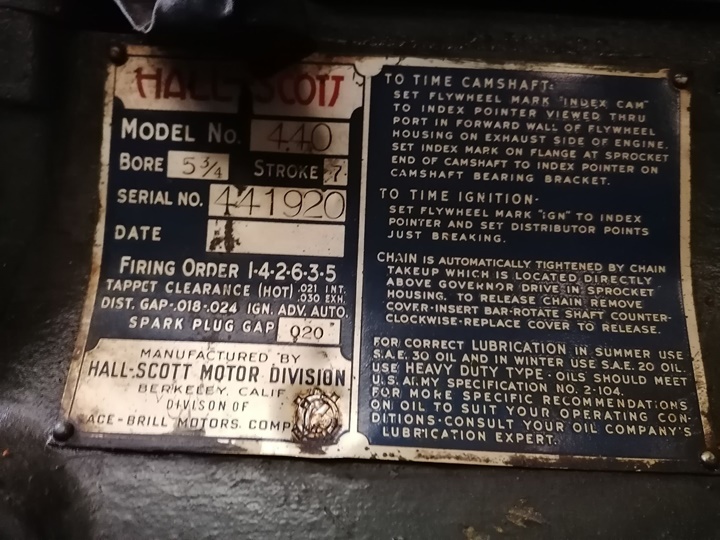
Photo courtesy of Vincent Torres added
11-8-2020.
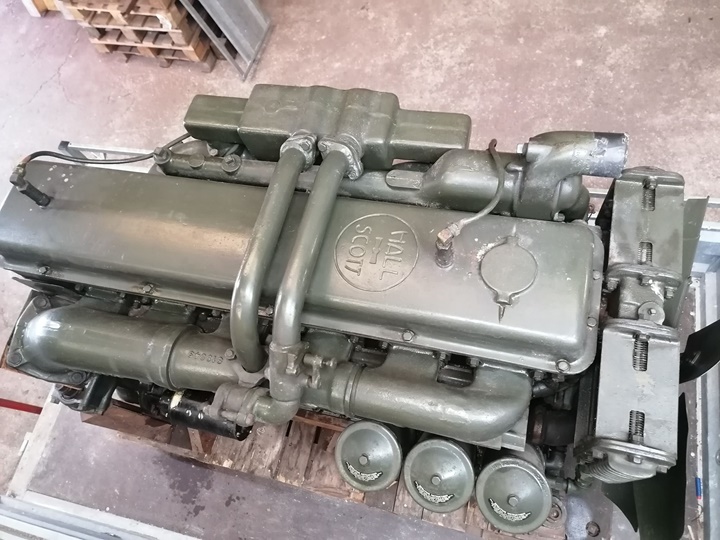
Photo courtesy of Vincent Torres added
11-8-2020.

Photo courtesy of Vincent Torres added
11-8-2020.
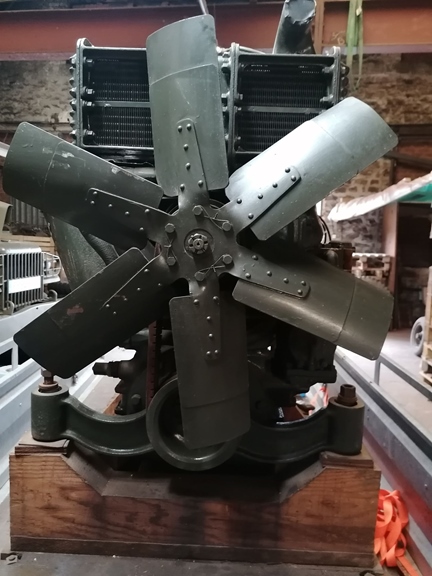
Photo courtesy of Vincent Torres added
11-8-2020.

The double-ended Mack T8 with a Hall-Scott
441 engine powering each tractor.
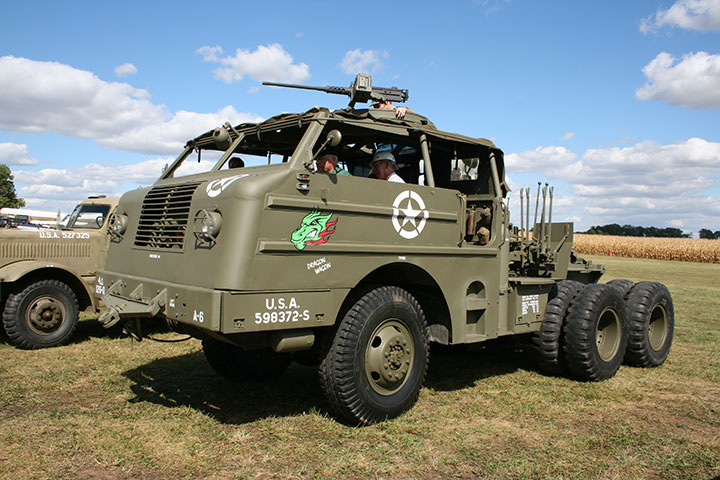
This M26A1 was seen at the 2013 MVPA Rally at the
former Ropkey
Armor Museum in Crawfordsville, IN. Luckily, I was able to see
and hear it drive around the grounds several times over the day I was
there.
Author's photo.
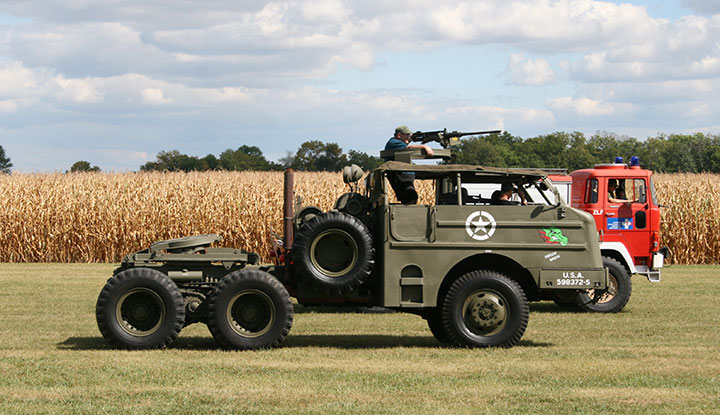
Author's photo.
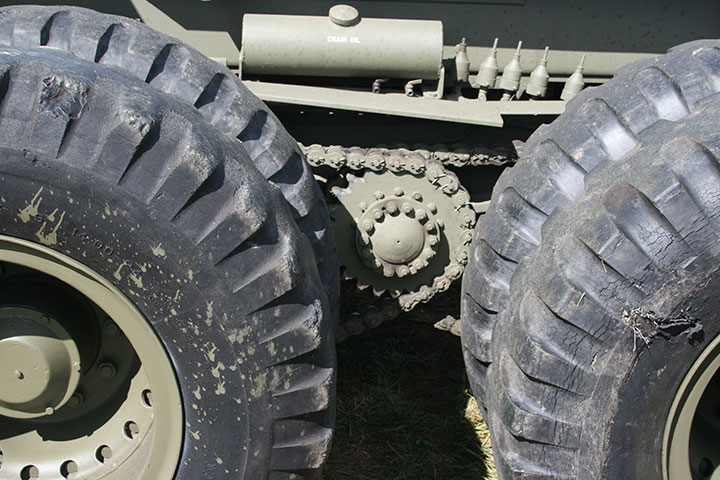
The Hall-Scott 440 engine powered a chain-drive drive the rear wheels. The chains
are driven by the rear axles. Author's photo.
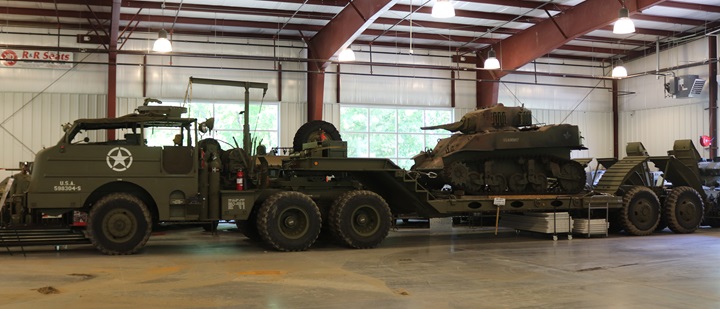
On display at the Museum of American Armor
in New Bethpage, Long Island, NY is this M25 tank transporter, which
consists of a M26A1 tractor and a M15A2 semi-trailer. The tractor
was built by Pacific Car and Foundry, and the trailer by Fruehauf
Trailer Company. Author's photo.
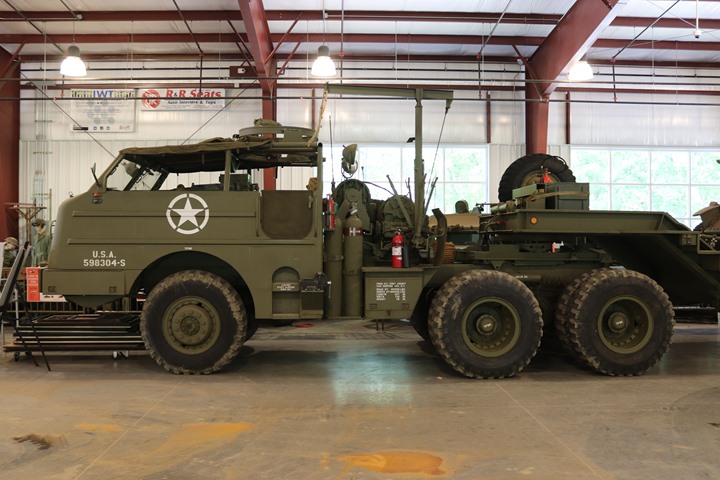
Author's photo.

As the World War Two advertisement above
shows, Hall-Scott Invader and Defender engines were used in a lot more
applications than the 440. The different boat types are shown in
the tables 2,3 and 4 below. The unidentified landing craft in the upper
left-hand corner of the ad is a Landing Craft, Vehicle (LCV).
|
Defender Engine usage in small boats during World War Two -
Table 2 |
|
Type |
Number built |
Engines per boat |
Total engines |
Comments |
| U.S.
Army Aircraft Rescue boat |
|
|
|
See
Table Below. |
|
British and Canadian Navy Fairmile Patrol Boat Series |
|
|
|
|
|
Fairmile A M/L Patrol Boat (Motor Gun Boat) - UK |
12 |
3 |
36 |
British built for RN |
|
Fairmile B M/L Patrol Boat (Motor Gun Boat) - UK |
593 |
2 |
1,186 |
British built for RN |
|
Fairmile B M/L Patrol Boat (Motor Gun Boat) - Canada |
62 |
2 |
124 |
Canadian built for RCN |
|
Fairmile C M/L Patrol Boat (Motor Gun Boat) - UK |
24 |
3 |
72 |
British built for RN |
| U.S.
Coast Guard Patrol Boat |
? |
|
? |
It is
unknown which Coast Guard Patrol boat the Defender engine was
used in. |
| U.S.
and British Navy Rescue Boats |
|
|
|
See
Table Below. |
| U.S.
Army Aircraft Rescue Boat |
|
|
|
See
Table Below. |
| U.S.
Army Aircraft Rescue Boat 104 foot (P110-115 141-145) |
11 |
3 |
33 |
There
were 93 104-foot rescue boats built. The original series
had Kermath Sea Raider engines. The next series, known as
the 200 series, was powered by the Hall-Scott Defender.
Only 11 of the 104-foot boats have been verified to have been
built with the Defender. There were probably more in the
200 series but the historical record does not verify this. |
|
British Naval Torpedo Boat - 70-foot Vosper MTB |
22 |
3 |
66 |
These
were replaced in 1942 with three Packard 4M2500 engines. |
|
Totals |
724 |
|
1,517 |
|
Hall-Scott Defender-Powered 63-foot Rescue Boats - Table 3
Below are all of applications for a Defender engine in this
rescue boat |
|
Model 63-Foot Rescue Boat |
Number built |
Number of Engines |
Total Engines |
Comments |
| 152 |
8 |
2 |
16 |
For
Great Britain. |
| 293 |
76 |
2 |
152 |
Subchaser version of the boat. Some went to Russia. |
| 314 |
352 |
2 |
704 |
U.S.
Navy = 240 boats. Some boats went to the Netherlands and the
U.K. The U.S.C.G. received 29 and U.S. Army Air Force
received 54. Australia was given 20. The ones that went to
the Coast Guard became its standard 63-foot rescue boat for
World War Two and into the 1950s. |
| 416
or Type 3 |
79 |
2 |
158 |
These
were built to U.S. Army specifications. |
| Mark
2 |
16 |
2 |
32 |
|
| Mark
3 |
69 |
2 |
138 |
|
| Mark
4 |
9 |
2 |
18 |
|
|
Total |
609 |
|
1,218 |
|
Invader Engine usage in small boats during World War Two -Table
4
Hall-Scott produced 1,692 Invader engines in 1942 before
turning over the tooling to Hudson Motor Company. These
1,692 engines were used in the following applications.
Hall-Scott Invader engines were specified for the LCP(L), LCV
and LCVP. However, the U.S. Navy preferred diesel engines
and the Gray Marine/Detroit Diesel 6-71 engine became the
standard engine for these type landing craft. When there
were not enough of the diesels to meet all of the needs of the
military, because it was used in Sherman tanks and Wolverine
tank destroyer, Invader and other gasoline powered engines were
substituted. The LCP(P) and LCV were both built in 1941
and 1942, so some of the Hall-Scott-built Invader engines were
probably installed in these boats. After 1942 the Hudson
Motor Company version of the Invader were used in the landing
craft. The LCVP and LCP(R) did not start production until
1942, so again a few Hall-Scott Invaders may have been used in
these. |
|
Type |
Number built with Invaders |
Engines per boat |
Total Engines |
Comments |
| LCV
(U.S. Navy Ramp Boat) 36-Foot |
? |
1 |
? |
The
Hall-Scott was one of the original engines specified for the LCV.
See engineering drawings below. |
| Coast
Guard 38-foot and 45-foot Picket boats |
? |
1 |
? |
There
were 500 of these built in 1942 and 1943. They used a
variety of engines including the Invader. |
| U.S.
Navy-Army 63-Foot Rescue Boat |
20 |
2 |
40 |
US
army got 6 of these. |
| LCP(L)
(U.S. Navy Landing Boat) 36-Foot |
? |
1 |
? |
The
Hall-Scott was one of the original engines specified for the
LCP(L). See engineering drawings below. |
| U.S.
Army 42-Foot Rescue Boat |
? |
2 |
? |
The
42-foot rescue boats were built with either Kermath Sea Raider
or Hall-Scott Invader engines. |
| LCP(R)
(Landing Craft, Personnel, Ramp) 36-Foot |
? |
1 |
? |
Production started on these in 1942. A few may have had
Hall-Scott-built Invader engines installed. |
| LCVP
(Landing Craft, Personnel, Ramp) 36-Foot |
? |
1 |
? |
Production started on these in 1942. A few may have had
Hall-Scott-built Invader engines installed. |
| |
? |
|
1,692 |
Based on 1942 production |

The Hall-Scott Defender Engine.
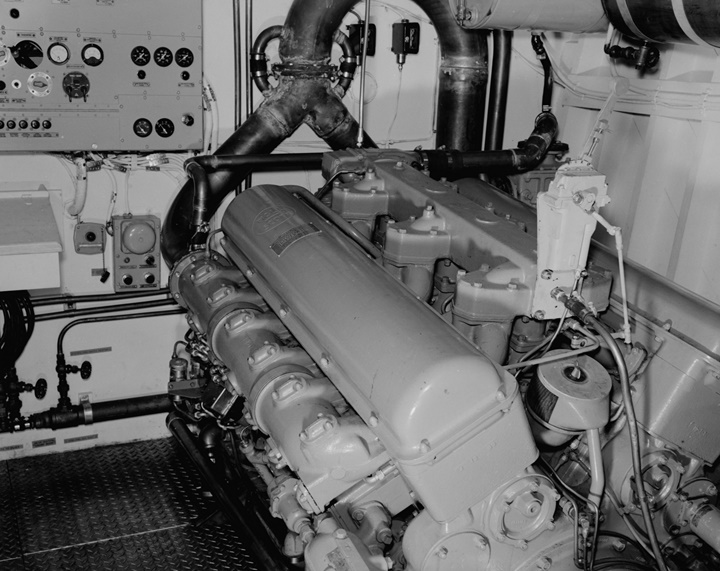
The Hall-Scott Defender installed in a
boat's engine room.
| Defender
Engine Models - Table 5 |
| Model Number |
|
Rotation |
Supercharged |
Comments |
|
| 1268 |
1996 cu. in.,5.5 inch bore with 7 inch stroke,
575hp @2100rpm |
Right hand |
No |
Original Defender |
|
| 1269 |
1996 cu. in.,5.5 inch bore with 7 inch stroke,
575 hp @2100rpm |
Left Hand |
No |
Original Defender |
|
| 2268 |
2181 cu. in., 5.75 inch bore with 7 inch stroke,
630 hp @2100rpm |
Direct Drive Right hand |
No |
|
|
| 2269 |
2181 cu. in., 5.75 inch bore with 7 inch stroke,
630 hp @2100rpm |
Direct Drive, Left Hand |
No |
|
|
| 2286 |
2181 cu. in., 5.75 inch bore with 7 inch stroke,
630 hp @2100rpm |
Reduction Gear Right Hand |
No |
|
|
| 2287 |
2181 cu. in., 5.75 inch bore with 7 inch stroke,
630 hp @2100rpm |
Reduction Gear, Left |
No |
|
|
| 3368 |
2181 cu. in., 5.75 inch bore with 7 inch stroke, 900hp @2100rpm |
Direct Drive Right hand |
Yes |
482 total
supercharged Defenders were built during World War Two of all
types. |
|
| 3369 |
2181 cu. in., 5.75 inch bore with 7 inch stroke, 900hp @2100rpm |
Direct Drive, Left Hand |
Yes |
|
|
| 3386 |
2181 cu. in., 5.75 inch bore with 7 inch stroke, 900hp @2100rpm |
Reduction Gear Right Hand |
Yes |
|
|
|
3387 |
2181 cu. in., 5.75 inch bore with 7 inch stroke, 900hp @2100rpm |
Reduction Gear, Left |
Yes |
|
|

This page of the operator's manual shows
that the Hall-Scott Invader engine was used in the 42-foot rescue boat.
Many of the engines were the Hudson-built version.
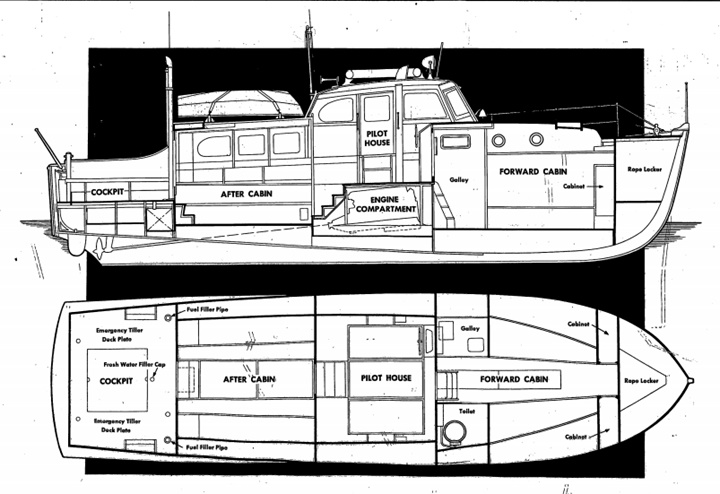
The 42-foot rescue boat was a Owens Yacht
Company design.
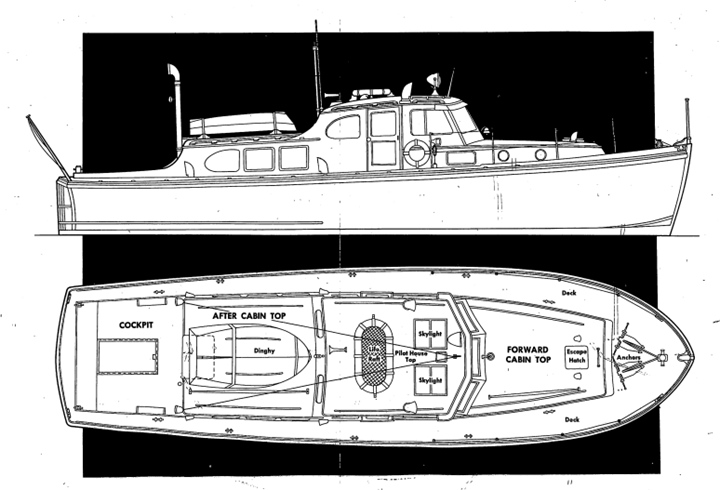
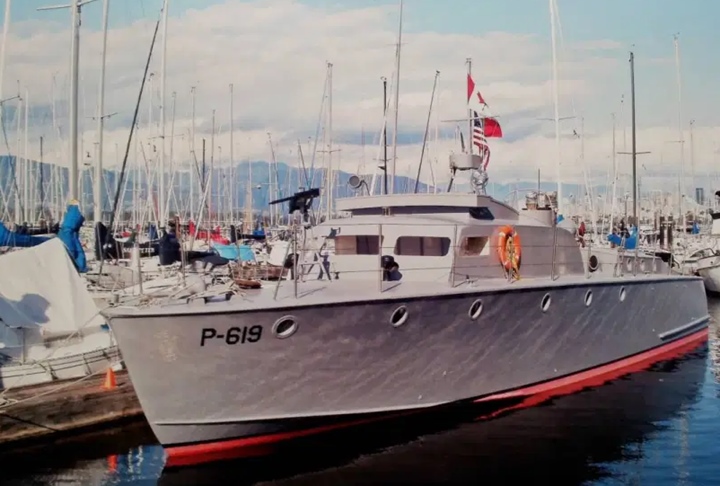
P-619 is a
63-foot rescue boat built by the Miami Shipbuilding Company of Miami, FL
in December 1943. It served in the Pacific and is now owned by a
private owner in Vancouver in British Columbia.

An artist's rendering of a Herreschoff-built
63-foot rescue boat in action.
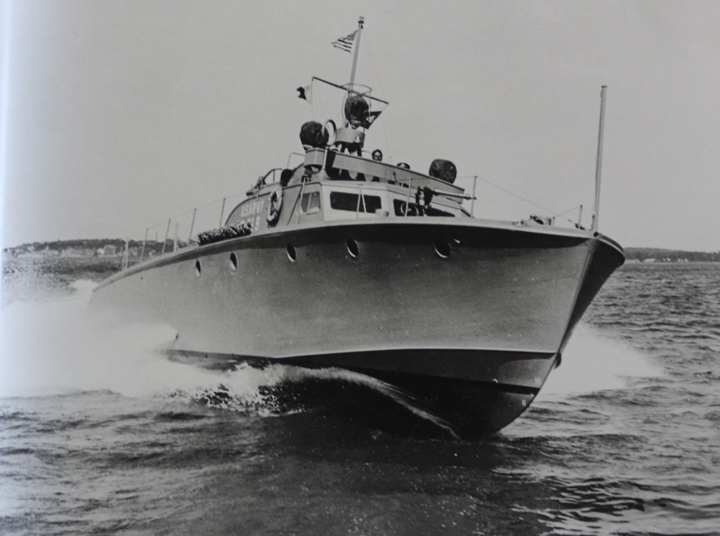
This 63-foot rescue boat built by the Herreshoff Manufacturing Company
is undergoing sea trials off the coast of Rhode Island before delivery
to the Army. U.S. Army can be read on the side of the bridge of
the boat. It appears to be number 639, completed on September 21, 1944.
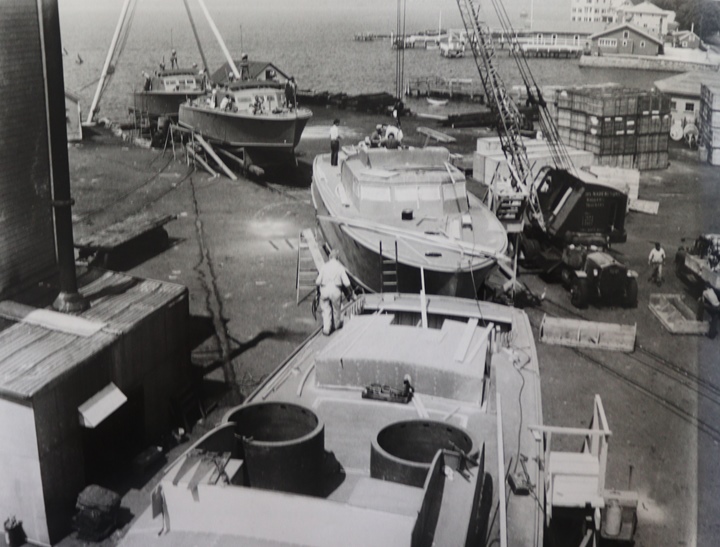
Four 63-foot rescue boats are being built on
an outside production line at the Herreshoff South Yard. A crane
is installing a Hall-Scott 630 hp V-12 "Defender" gasoline engine.
Each 63-foot rescue boat was powered by two of the engines. Herreshoff
delivered 36 of the 63-foot rescue boats between August 1, 1944 and
January 8, 1945. This was a delivery rate of more than one a week.
The next three documents are records from the Herreshoff Manufacturing
Company during World War Two. The documents below show that the
company was installing the 630- hp version of the Defender engine in the
63-foot rescue boats it was building. It also shows the customer
for each boat.

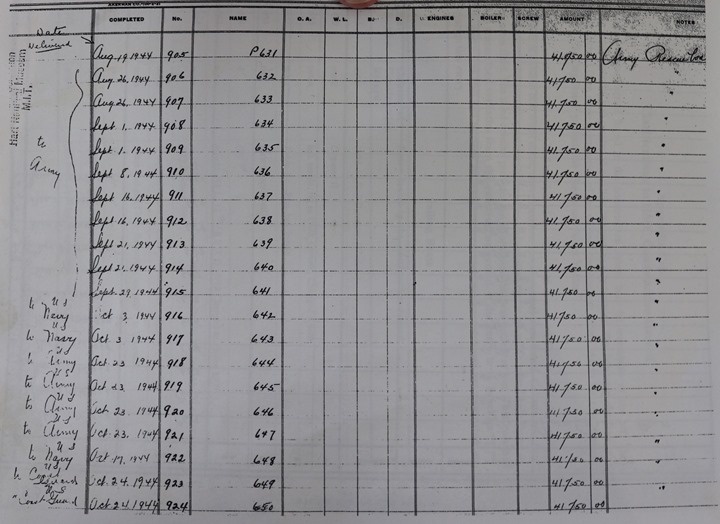


This 1944 Landing Craft, Personnel, Large (LCP(L))
was the first type of landing craft that Andrew Higgins designed.
This particular boat was built by Higgins Industries in New Orleans in
October 1944, and is currently on display at the National WWII Museum in New Orleans.
It has returned home for museum visitors to see. It is the
only one on display left in the world. Hall-Scott Invader engines
were one of several specified for this landing craft by Higgins
Industries. Also specified were Gray/Detroit Diesel and Superior
Diesel engines. Author's photo.

Note the location of the coxswain's steering
station, the two gun tubs for mounting self-defense machine guns and the
engine housing in the middle of the boat.
Note also that the 25 armed troops carried in the craft were in two
different sections of the LCP(L). Author's Photo.

This Higgins Industries engineering drawing
shows the location of the engine in the 36-foot Landing Craft. Personal
boat or LCP(L).

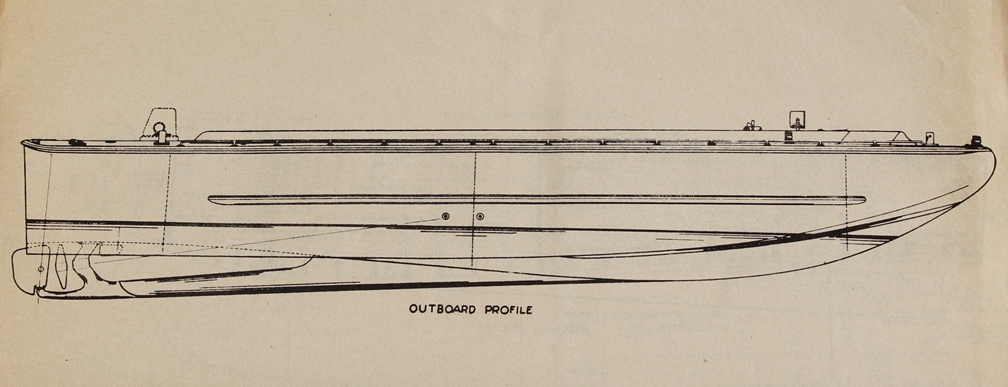

This Higgins Industries engineering drawing
shows the plumbing in the 36-foot LCP(L) boat with a Hall-Scott Invader
engine fresh-water cooling system.

The date on the drawing is 11-4-41, a month
before Pearl Harbor, and the buildup of the American military forces to
fight a two-front war. Hall-Scott Invader engines were being
specified as one of the engines for the current landing craft being
built by Higgins Industries. The Gray Marine diesel engine has a
similar drawing. It is dated the day before this one, 11-3-41.

The LCP(L) was also known within Higgins
Industries as an Eureka landing boat.

This Higgins Industries engineering drawing shows the plumbing in the
36-foot Landing Craft, Personal boat with a Hall-Scott Invader engine
fresh-water or salt-water cooling system.
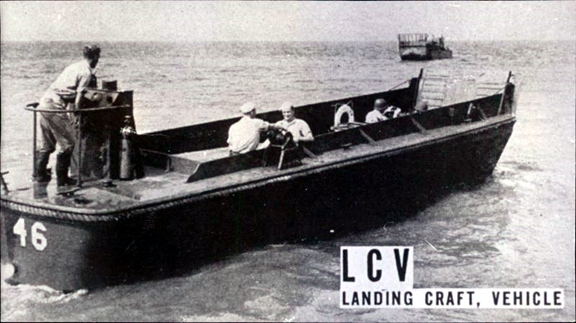
There were 2,633 LCVs built between 1941
and 1943 by Higgins Industries, Chris-Craft, Richardson, and Owens Yacht.
While not built in the
quantities of the LCVP, LCVs saw duty in early American invasions in
World War Two. It continued to be utilized even after the LCVP
became the dominant landing craft later in the war. Hall-Scott
Invader engines were specified for this landing craft.
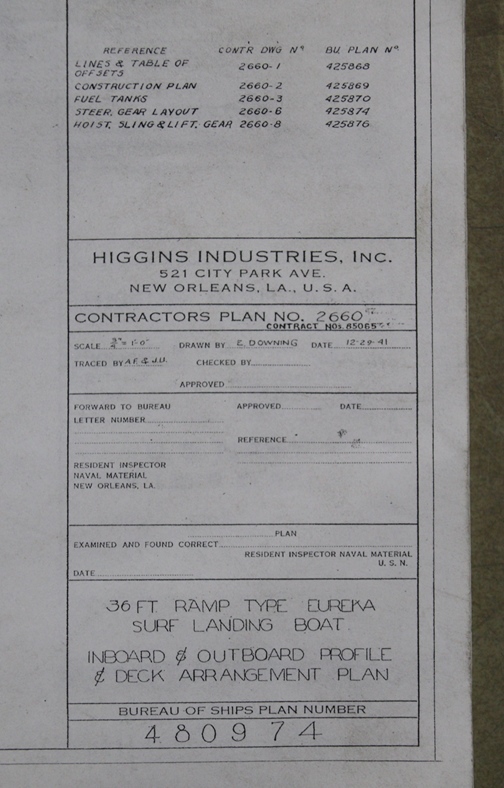
The name given to the LCV at the time of
this drawing on 12-29-1941 was 36 Foot Ramp Type Eureka Surf Landing
Boat. Engineering drawing courtesy of C. Robert Gillmor.
 Engineering drawing courtesy of C. Robert Gillmor.
Engineering drawing courtesy of C. Robert Gillmor.

The Hall-Scott Invader engine is
shown in this drawing. Engineering drawing courtesy of C. Robert
Gillmor.

The name "Invader" can also be seen on this document.

Hall-Scott was specified for the LCV with either fresh or salt water
cooling on 9-17-41.

The name "Invader" can also be seen on this document.
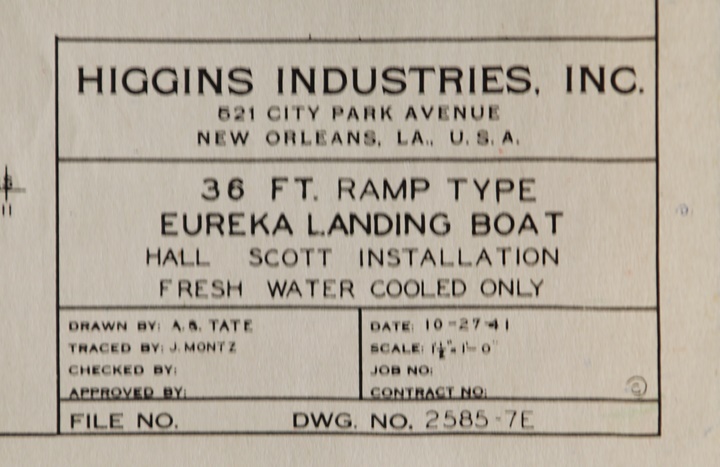
Hall-Scott was specified for the LCV for fresh water cooling on 9-17-41.
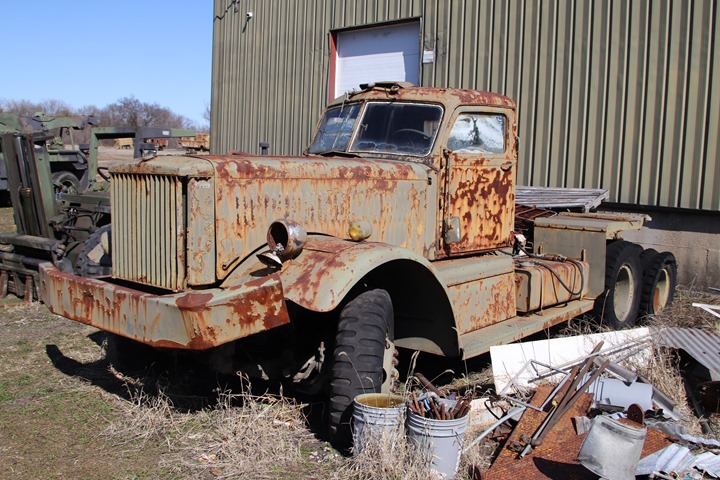
This Diamond T M20, 12-ton 6x4 truck is awaiting restoration at the
Indiana Military Museum in Vincennes, IN. Author's photo added
3-2-2020.

Author's photo added 3-2-2020.
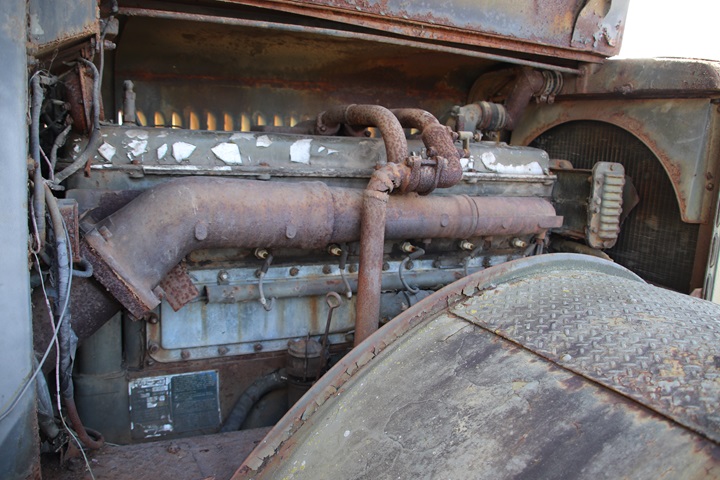
What is wrong with this photo? The M20
was originally powered by a Hercules DXFE diesel engine. A
post-war owner has replaced the original Hercules diesel with a
Hall-Scott 440 engine, which was only used in the M26 and M26A1 tank
transporters of World War Two. Author's photo added 3-2-2020.
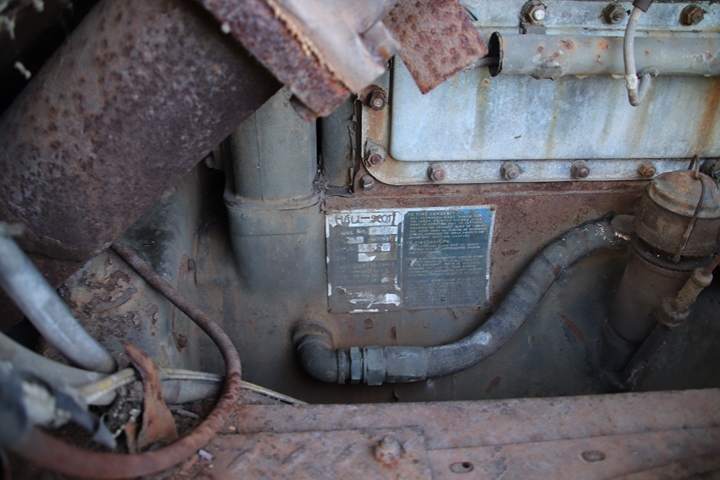
Author's photo added 3-2-2020.

This is serial number 441805. Assuming
that the first two number designate the engine as the 440, then this was
the 1,805 440 engine built. This conflicts with the historical
record that indicates 1,701 of the 440s were built. Just one of
the many mysteries of World War Two production. Author's photo
added 3-2-2020.
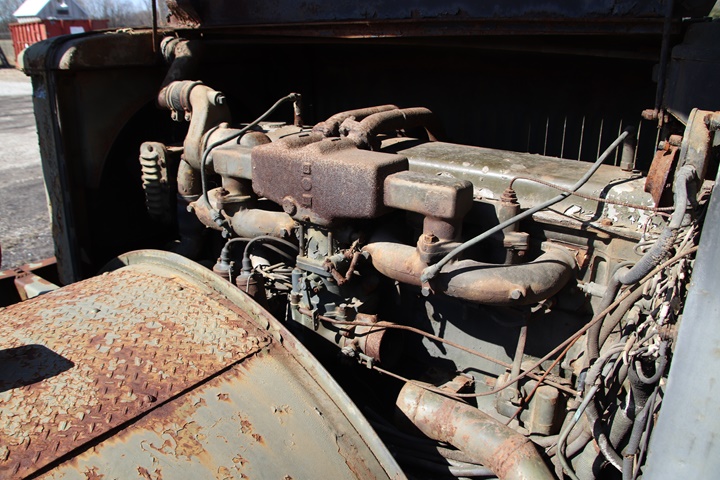
Author's photo added 3-2-2020.
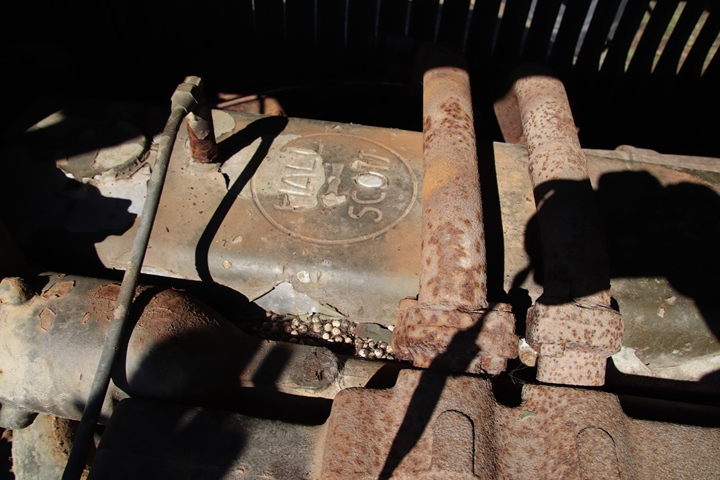
Author's photo added 3-2-2020.
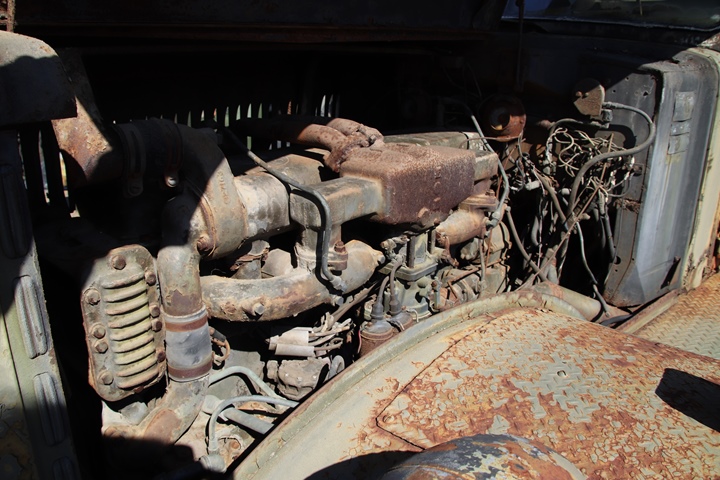
Author's photo added 3-2-2020.
Post-World War Two: Also at the
Indiana Military Museum is this M2A1 howitzer that was built in 1955
with a Hall-Scott recoil mechanism. There is no reference to
Hall-Scott building these in the historical record. Most likely
these were built by its industrial products division.

Author's photo added 3-2-2020.
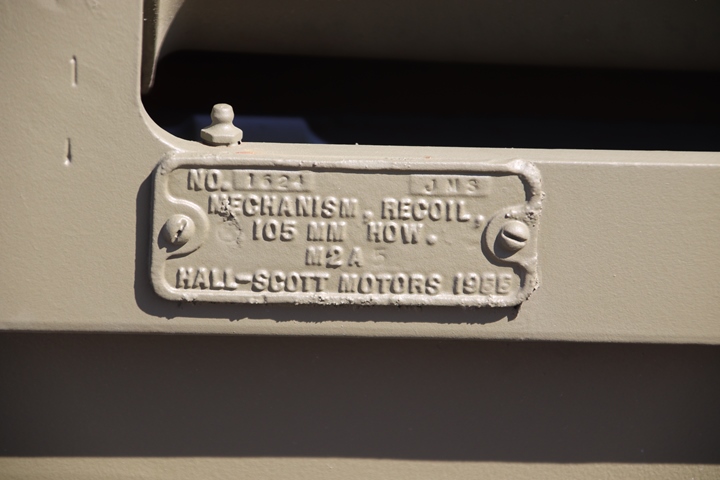
Author's photo added 3-2-2020.
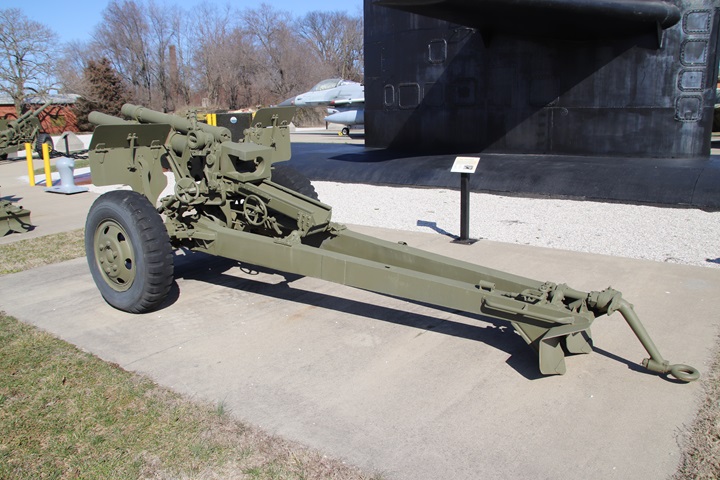
Author's photo added 3-2-2020.
|






































 Engineering drawing courtesy of C. Robert Gillmor.
Engineering drawing courtesy of C. Robert Gillmor.














